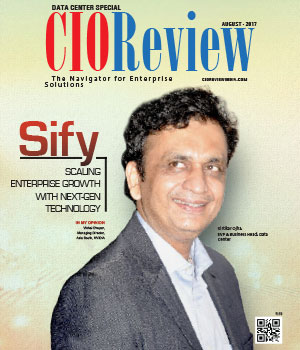
Data Centre is Becoming an Ecosystem of Services & Partnerships
Vishal Pratap Singh | Monday, 09 May 2022, 08:49 IST

Rohit Singal, Vice President, Sales, Rahi-Data Centres in an interaction with CIOtechOutlook, shares his insights on the current emphasis shifts from infrastructure to workloads, Hyperscale Data Centres, data flow and more.
Gartner said that IT leaders need to shift their focus from infrastructure – on-premises, in the cloud or at the edge of the network – to workloads. When the emphasis shifts from infrastructure to workloads, decision-making can focus on service delivery rather than managing IT. How do you see this transition from the Indian perspective?
In a post-pandemic world, it is best to shift workloads to the cloud to get benefits and prepare for the next unexpected disruption. When the emphasis shifts from infrastructure to workloads, decision-making focuses on service delivery rather than IT architecture. Although Gartner recommends that IT get out of the business of maintaining data centres, the cloud is not the best option (Link). Organizations should focus on performance, availability, security, compliance and other technology and business needs in order to determine workload placement. In analyzing these factors, organizations should consider not only what internal IT stores can offer but also what is available in the market. Some legacy applications can be moved to Software-as-a-Service solutions, but others can be hosted in colocation environments. For example, emerging distributed cloud services can prove to be a good option as they allow running applications and data from geographically dispersed sites at the network edge.
The hyper-scale data centre is reshaping the IT landscape, allowing cloud-based companies to maintain global significance in an increasingly competitive industry. How is the Hyperscale Data Centres reshaping the IT landscape of India?
With increased usage and more dependability on IT infrastructure everything is growing and becoming ‘Hyper’. Data Centres are now trying to work with renewable energy to better utilize their resources and reduce environmental impacts. The trend will continue, and we will be seeing more and more innovation in sustainable components with improved efficiency. A Hyperscale Data Centre is a large warehouse-like structure with its own servers, routers, storage system, powerhouse, and networks. This is often used for big data and cloud-based applications. With the growing demand for data, Hyperscale Data Centres are expected to grow at a tremendous rate over the next decade. We can see emerging trends across Hyperscale Data Centres and these trends are driving the overall growth. Hyperscale data centres are capable of managing the volume of data, compute, and storage services they process. Cloud computing, software platforms, social media, and content delivery are some of the factors that are driving the growth of the Hyperscale Data Centres.
Many industries that once had very little or no access to IT infrastructure are now moving to the cloud-based system, largely driven by remote operating needs. Healthcare, supply chain and logistics, educational institutions are primarily focusing on cloud-based solutions. This has given a great boost to the Hyperscale data centers. These Hyperscale Data Centers offer unique ways to save energy and functionality that will make them the preferred choice of facility for many companies.
With businesses modernizing their IT infrastructure by integrating new technologies with old ones, maintaining the data flow becomes challenging. How do you propose to overcome this challenge?
To modernize IT infrastructure, businesses must migrate to cloud, either hybrid or private or public to store their data. Simultaneously, it is imperative to streamline these processes as several challenges that may arise need to be addressed in order to make a successful transition to cloud.
Data Management: There exists a huge amount of data, and new data is added daily, making data structuring a big issue. It is thus necessary to ensure that the storage available on cloud is optimized and automated so that it’s easier to access the data virtually and integrate it with the organization’s IT infrastructure.
Authorize Mobility: With everyone working remotely or in a hybrid space, organizations have made data accessible from any location with stable Wi-Fi and on any device. The process may have pitfalls due to multiple access points.
Data protection: Accessibility to data from any location is risky. It leaves the data vulnerable as it is available to anyone with any device. Ensuring data protection and security is a concern that many organizations face.
Customization: Every organization has a specific and unique need. Therefore, every organization’s transition is different and finding the right fit to set up cloud storage especially during a pandemic might be a huge task.
With virtualization, server security has become more complex and challenging. It is imperative to follow industry standards to ensure complete server security with 24×7 monitoring, intrusion detection and intrusion prevention. How can the security challenges be overcome?
The increasing volume and sophistication of cyber threats put organizations of all sizes at risk. To combat these threats, organizations must take a strategic approach to cybersecurity. However, many organizations lack effective information security governance that incorporates the needed policies, processes, and controls. Gartner defines security governance as a framework for prioritizing risks so that the efforts are focused on business priorities. Organizations that don’t utilize a governance framework cannot select the right technologies to address the most severe threats. Growing numbers of security tools generate vast alerts in many organizations, making it difficult to monitor the IT environment and detect security incidents.
Here are the key elements of a modern approach to defining a comprehensive Enterprise Security Strategy.
Zero Trust Network Access (ZTNA): In a zero-trust approach, all users, devices, and applications are not of trust, to begin with. Authentication works according to admin-defined criteria and grants only certain privileges based on their role for a certain period of time. It is similar to a whitelist model.
Software-Defined Perimeter: Software-Defined Perimeter solutions grant users selective access to specific resources based upon device, location, time of day, and other variables. Access controls extend to the content level, dictating what users can and cannot do with data, such as downloading or attaching to an email.
Identity and Access Management (IAM): In a zero-trust model, the perimeter is constantly moving based on the location of users and the applications they access. Effective identity management is foundational to this approach. Identity and Access Management (IAM) solutions provide a means of managing user identities and credentials. Authenticating users, and granting them access to the resources they need. They provide capabilities such as single sign-on, multi-factor authentication, and federated identity management.
Mobile Device Management: In today’s era of BYOD proliferation and users working on their phones increasingly, mobile device management (MDM) remains essential to any security strategy. Remote and mobile users are using their personal devices to access business-critical applications and data. IT teams need visibility into the security posture of those devices and a means of enforcing policies across the enterprise. The MDM solution should be compatible with the single sign-on and multifactor authentication approach in the organization’s IdM environment. It should also incorporate zero trust principles.
Data Loss Prevention (DLP): While most security tools are designed to prevent threats from entering the network, data loss prevention (DLP) focuses on protecting sensitive data from leaving the organization. DLP solutions enable organizations to classify data and enforce policies on how that data can be accessed, shared, and stored. DLP solutions are increasingly being deployed in a Zero Trust environment in the CDN (content delivery network) clouds that have a variety of security capabilities such as threat detection, sandboxing, secure web gateway, CASB, etc.
Extended Detection and Response (XDR): Extended detection and response (EDR) solutions continuously monitor endpoints for suspicious behavior and automatically take action to prevent threats. They collect and process security event feeds and use analytics to protect against advanced persistent threats and zero-day attacks.
How do you envision the future of the data centre market in India? What are the upcoming trends that will shape the future of this industry?
The demand for data centres is growing in India due to rapid adoption of digital infrastructure amid the pandemic, rising digital usage, increasing dependency on cloud and 5G rollout. 2022 is expected to be a milestone year for the data center industry in India. Mumbai and Chennai are the most preferred locations to set up data centre facilities owing to business and infrastructure advantages, strategic location and cable landing station. Delhi-NCR, Hyderabad, Bengaluru and Pune will also contribute to the growth of the data centre industry. The data protection law, increasing demand from cloud players, migration to cloud and government's digital initiatives and investments will add to the growth of the data centre industry in India. The growing data security concerns, digital disruptions and digital usage emerging from distributed workforce have also led to the growth of data centers. Home-grown video and gaming platforms are fueling the data center industry demand. The investors and global data centre players have announced joint ventures to meet expected demand during the last six months in India.
We have listed below 5 trends in the data center industry that will empower digital transformation in 2022.
Hyper-Scalability of Data Centers: Hyperscale Data Centres, also known as ultra-scalability, are based on the concept of on-demand provision of IT resources and distributed systems. A large number of servers work together at high-speed giving it the ability to expand horizontally and vertically enabling more efficient storage and transfer of data. There will be an increase in demand for hyperscale data centres as the demand for data and data localization is rising. Mumbai and Chennai will be leading data center hubs owing to power supply, undersea cablings, and a large user base.
The Rise of Small Data: Small data is linked to edge computing in applications that require low latency. Small data infrastructure facilitates rapid analysis of most of the data for cases where factors like time and bandwidth are of higher importance. Small data representing edge computing doesn’t eliminate the need for data centres, in fact, data centers play a crucial role in this. We will see huge growth in devices using small data capabilities with recent developments in self-driving cars, industrial automation, internet of things, and wearable devices.
Data Centers Going Green and Getting More Sustainable: ‘Going Green’ is now more than just an industrial objective but is being aggressively adopted to achieve the aim of negative carbon footprints. Data center service providers and businesses are examining energy efficiency, water usage, and waste output generated. 2022 will see a major paradigm shift in the climate action framework being adopted by businesses globally. The case for sustainability doesn’t rest at Power Usage Effectiveness (PUE), since data centers use 1000s of gallons of water on a daily basis, DC providers are also focusing on Water Usage Effectiveness (WUE). Many massive data centers are now installing air-cooled systems working in a continuous closed loop to avoid excess water usage.
DC Infrastructure Remote Management: Data centers operate 24*7*365 days. On average 1-minute downtime cost of a DC system is $7900. The presence of on-site technicians and engineers was a necessity but pandemic and employee shortage posed a threat of DC system outage with no one on-premise. One of the most prominent and essential improvements brought due to Covid-19 is the Remote Infrastructure Management (RIM), which allows businesses to control their data center infrastructure remotely. RIM includes remote monitoring of security and network services, desktop administration, database management, and server management. Developments of RIM began in pandemic and now it’s reshaping the DC industry.
AI & Automation to Ease DC Workability: One of the major impacts of the pandemic was the shortage of on-site technicians and engineers to take care of problems associated with the data centers. AI and machine learning helped in remote management and monitoring of the DC systems and automation helped in managing infrastructure physically using robotics. A far-fetched dream has turned into a reality with AI and automation being integrated into data center facilities. With the increased demand for data, data centers are scaling at a rate that will soon bypass the managing capabilities of human staff. 2022 will witness a growth in automation and AI for managing and monitoring data centers.
CIO Viewpoint
India and its Data Center Advancements
By By Michael Cantor, CIO, Park Place Technologies
How AI/Machine Learning can Revamp Data Centers...
By Piyush Kumar Chowhan, CIO and Vice President, Arvind Lifestyle Brands Limited
By Sanjay Chowdhry, CIO, Hamdard WAKF Laboratories
CXO Insights
Why A Data First Approach Could Be Your...
By Geetha Ramamoorthi, Managing Director, India, KBR Inc
A Short Guide for Data-driven and...
By Kapil Makhija, VP - Technology Cloud Business, Oracle India
The burgeoning market of prompt engineering in...







